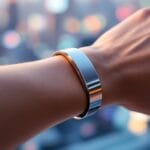You’ve likely wondered if smart glasses, like Ray-Ban Stories, are the future or just a passing trend. They offer handy AR features that boost your daily tasks, yet nagging issues like short battery life raise questions. What truly sets them apart? Stick around to find out.
Top Smart Glasses Models
When you’re exploring the top smart glasses models, you’ll discover options like Ray-Ban Stories and Vuzix Blade that lead the pack with features like augmented reality displays and hands-free controls, making them ideal for everyday use.
You’ll find these models stand out for their stylish designs and seamless integration into daily life, such as during workouts or social outings.
These models stand out with stylish designs and seamless integration into daily life, like workouts or social outings.
Other contenders, like North Focals and Epson Moverio, offer competitive choices that blend fashion with functionality, appealing to tech enthusiasts.
As you compare them, consider factors like battery life and compatibility with your devices to pick the perfect fit.
These leaders in the market push boundaries, enhancing how you interact with the world around you.
Whether you’re a professional or casual user, they provide innovative solutions that feel intuitive and accessible.
Key Features Analysis
The key features of smart glasses, like augmented reality displays and hands-free controls, make them a game-changer for users seeking seamless tech integration.
You experience augmented reality overlays that project digital info directly into your view, helping you navigate cities or check notifications without pausing.
Hands-free controls let you manage calls, messages, or apps via voice commands, freeing your hands for multitasking.
Integration with smartphones means you’re syncing data effortlessly, from GPS directions to fitness tracking.
Built-in cameras capture your world hands-free, while customizable interfaces adapt to your preferences for a personalized fit.
These elements enhance daily life, turning ordinary tasks into efficient, tech-driven experiences.
As you wear them, you’ll find they bridge the gap between digital and physical worlds, boosting productivity without overwhelming you.
Performance Evaluation
Performance evaluations of smart glasses reveal how they handle real-world demands, from battery life to responsiveness.
You’ll notice that top models, like those from leading brands, deliver impressive battery endurance, often lasting a full day of moderate use without needing a recharge.
This keeps you connected and efficient throughout your activities.
Regarding responsiveness, these devices process commands swiftly, ensuring you interact seamlessly with apps and notifications.
For instance, gesture controls respond almost instantly, reducing lag that could frustrate users.
Durability also plays a key role; you’ll find that robust builds withstand everyday wear, maintaining performance over time.
Overall, when you test these glasses, their reliable execution makes them a strong contender, though not without occasional hiccups in connectivity.
Weigh these factors as you decide if they’re worth your investment.
Real-World Applications
Smart glasses excel in everyday scenarios, letting you navigate hands-free through busy streets or overlay repair instructions on machinery.
You’ll find them transforming your daily routine, whether you’re exploring new cities or tackling hands-on tasks with augmented guidance.
They make complex activities intuitive, boosting efficiency in work and leisure without distracting from the moment.
They simplify complex tasks, enhancing efficiency in work and leisure while keeping you fully present.
- Imagine you’re jogging in the park, and the glasses display your pace and heart rate in your field of view, keeping you motivated.
- Picture assembling furniture at home, with step-by-step visuals popping up to guide your every move.
- Envision touring a foreign city, where translations of signs appear instantly, helping you communicate effortlessly.
- Think of inspecting a car engine, as the glasses highlight potential issues with color-coded alerts.
- Visualize attending a live concert, with artist bios and lyrics overlaying your view for an immersive experience.
Battery and Design Aspects
Battery life and design greatly shape your smart glasses experience, delivering reliable power for all-day use while prioritizing comfort and style.
You rely on a strong battery to keep your device running through meetings, workouts, or commutes without constant recharges—aim for at least 8 hours of mixed use to avoid frustration.
Factors like screen brightness and connectivity drain power quickly, so you optimize settings for efficiency.
On the design front, lightweight frames and flexible materials help you wear them comfortably for extended periods, reducing strain on your ears and nose.
Sleek aesthetics let you blend tech with fashion, making them less intrusive in daily life.
You appreciate intuitive controls, like touch-sensitive temples, that enhance usability without bulk.
Ultimately, these elements make your smart glasses a seamless extension of your routine, balancing functionality with everyday wearability.
Brand Comparisons
When comparing smart glasses brands, you’ll quickly see how options like Ray-Ban, Snap, and Google differ in key areas such as innovation, price, and user experience.
Ray-Ban emphasizes fashion-forward designs that make you feel stylish, while Snap focuses on fun, social features to keep you engaged.
Ray-Ban highlights trendy designs for a stylish edge, while Snap delivers playful social tools to spark engagement.
Google’s models push tech boundaries, offering intuitive AI that enhances your daily life, but they come at a premium.
You’ll weigh these based on what matters most to you, from affordability to cutting-edge capabilities.
- Imagine Ray-Ban’s sleek frames merging classic style with smart tech, making you look effortlessly cool.
- Picture Snap’s glasses snapping photos of your adventures, turning everyday moments into shareable memories.
- Envision Google’s AI guiding you through notifications, like a personal assistant on your face.
- Think of affordable options that still deliver vibrant displays, putting high-tech within your reach.
- Visualize seamless connectivity that lets you control apps with a glance, boosting your productivity on the move.
Investment Considerations
Before diving into smart glasses, you’ll want to evaluate the investment from both financial and practical angles.
Financially, these devices range from $200 to over $1,000, depending on brands like Ray-Ban or Vuzix, so weigh the upfront cost against your budget.
Don’t overlook ongoing expenses, such as app subscriptions or repairs, which could add up quickly.
If you use them for work, like hands-free navigation, they might pay off through increased efficiency.
Practically, assess how smart glasses fit your lifestyle.
You’ll need to evaluate battery life, which often lasts only a few hours, and comfort for all-day wear to avoid headaches.
Test compatibility with your phone or smart home setup to guarantee seamless integration.
Ultimately, ask if they solve real problems or just gather dust, making your purchase worthwhile in the long run.
Conclusion
As you weigh the pros of smart glasses—like seamless navigation and real-time alerts—against their battery woes and connectivity hiccups, you’re left deciding: Are they the future of wearables or just a gimmick? Jump in, test them out, and see how they fit your life; with ongoing refinements, they’ll likely evolve into essential tools if adoption grows.







